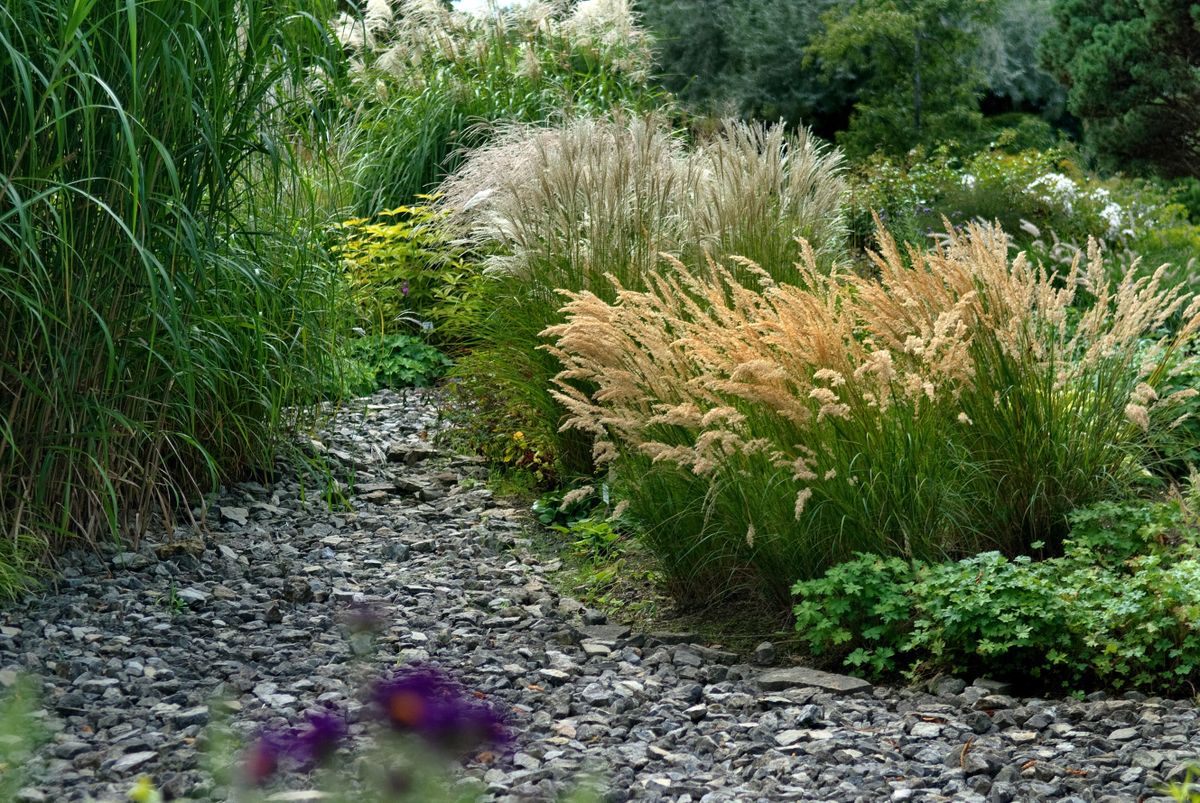How to Achieve a Thriving Lawn by Planting Grass Seed in September: September is often considered the ideal time to plant grass seed, offering a window of opportunity for successful germination and establishment. The cooler temperatures and increased rainfall of autumn provide the perfect environment for new grass to take root and thrive.
By following a few key steps, you can create a lush, healthy lawn that will be the envy of your neighborhood.
This comprehensive guide will walk you through the process of planting grass seed in September, from preparing the soil to choosing the right seed and maintaining your new lawn. We’ll cover everything you need to know to achieve a thriving lawn that will beautify your yard for years to come.
The Benefits of Planting Grass Seed in September
Planting grass seed in September offers several advantages over other times of the year, making it an ideal month to establish a healthy and vibrant lawn. The cooler temperatures and consistent rainfall during September create a favorable environment for grass seed germination and growth.
Favorable Weather Conditions for Grass Seed Germination and Establishment
September’s weather conditions provide an optimal environment for grass seed germination and establishment. The cooler temperatures and consistent rainfall are crucial for successful grass growth.
- Cooler Temperatures:Cooler temperatures in September reduce the risk of seed dehydration and promote healthy root development. The ideal temperature range for grass seed germination is between 65°F and 75°F.
- Consistent Rainfall:September typically experiences consistent rainfall, which provides the necessary moisture for seed germination and early root growth. Rainfall helps keep the soil moist, allowing the seeds to absorb water and germinate.
The Potential for a Lush, Healthy Lawn
Planting grass seed in September provides a significant opportunity to establish a lush, healthy lawn. The favorable weather conditions allow for strong root development and vigorous growth, setting the stage for a thriving lawn in the coming seasons.
- Strong Root Development:Cooler temperatures and consistent moisture encourage deep root development, providing a strong foundation for the lawn.
- Vigorous Growth:The cooler temperatures and adequate moisture stimulate vigorous growth, resulting in a lush and healthy lawn.
- Reduced Competition from Weeds:September is a time when weed growth slows down, reducing competition for resources and allowing the grass seed to establish itself more effectively.
Preparing the Soil for Successful Seed Planting
Preparing the soil is crucial for successful grass seed germination and establishment. A well-prepared seedbed provides the ideal environment for roots to develop and thrive, ensuring a healthy and vibrant lawn. This section Artikels the essential steps involved in preparing the soil for planting grass seed in September.
Testing Soil pH
Soil pH is a measure of its acidity or alkalinity, influencing the availability of nutrients to plants. Ideal soil pH for most grasses ranges from 6.0 to 7.0. Testing soil pH helps determine if adjustments are needed to optimize conditions for grass seed germination and growth.
- Soil Test Kits:Available at garden centers and online, these kits provide a quick and easy way to test soil pH. Follow the instructions provided with the kit for accurate results.
- Soil Testing Labs:For more comprehensive analysis, contact a local soil testing lab. They can analyze various soil properties, including pH, nutrient levels, and organic matter content, providing detailed recommendations for soil amendments.
Once the soil pH is determined, you can adjust it if necessary. To increase soil acidity (lower pH), use elemental sulfur or aluminum sulfate. To decrease acidity (raise pH), apply lime. The amount of amendment needed depends on the desired pH change and the soil type.
For example, a soil with a pH of 5.5 might require 5-10 pounds of lime per 1,000 square feet to raise it to the ideal range of 6.0 to 7.0. Always follow the instructions on the product label for proper application rates.
Removing Weeds, Debris, and Thatch
Weeds, debris, and thatch can hinder grass seed germination and growth. Removing them creates a suitable seedbed that allows the grass seed to make direct contact with the soil.
- Weeds:Existing weeds compete with grass seedlings for nutrients, water, and sunlight. Control weeds by hand-pulling, using a hoe, or applying a pre-emergent herbicide before planting.
- Debris:Remove any leaves, twigs, or other debris from the lawn surface. This ensures that the grass seed has direct contact with the soil and receives adequate sunlight.
- Thatch:Thatch is a layer of dead and decaying organic matter that accumulates between the soil and the grass blades. Excessive thatch can prevent water and nutrients from reaching the roots. Remove thatch using a dethatching rake or a power dethatcher.
Choosing the Right Grass Seed for Your Region
Selecting the appropriate grass seed for your region is crucial for a thriving lawn. Different grass types possess unique characteristics that make them better suited for specific climates and growing conditions.
Grass Seed Types and Their Suitability
The type of grass seed you choose will depend on your region’s climate, soil type, and desired lawn appearance. Understanding the characteristics of different grass types is essential for making an informed decision.
- Cool-Season Grasses:These grasses thrive in cooler temperatures and are best suited for regions with temperate climates. They typically go dormant during the summer months when temperatures are high.
- Kentucky Bluegrass:Known for its deep green color, dense growth, and ability to tolerate shade.
It’s well-suited for regions with cool, humid summers and cold winters.
- Fine Fescue:Tolerates shade and drought better than other cool-season grasses. It’s an excellent choice for lawns with partial shade or in areas with limited water availability.
- Perennial Ryegrass:This fast-growing grass is often used for overseeding or for establishing new lawns quickly.
It provides excellent wear tolerance and recovers well from foot traffic.
- Kentucky Bluegrass:Known for its deep green color, dense growth, and ability to tolerate shade.
- Warm-Season Grasses:These grasses prefer hot, humid climates and thrive in regions with warm summers. They typically go dormant during the winter months when temperatures are cold.
- Bermuda Grass:A popular choice for lawns in the southern United States due to its ability to withstand heat and drought.
It forms a dense, low-maintenance lawn.
- Zoysia Grass:Known for its deep green color, slow growth rate, and excellent wear tolerance. It’s well-suited for lawns with high traffic and requires minimal mowing.
- St. Augustine Grass:This grass thrives in warm, humid climates and is often used for lawns in the southeastern United States.
It’s known for its lush, green appearance and tolerance to salt spray.
- Bermuda Grass:A popular choice for lawns in the southern United States due to its ability to withstand heat and drought.
Planting Grass Seed

Planting grass seed in September offers several advantages, including cooler temperatures, less competition from weeds, and ample moisture from fall rains. With proper preparation and execution, you can establish a lush, healthy lawn that will thrive in the coming seasons.
Planting Grass Seed: A Step-by-Step Guide
To ensure successful seed germination and establishment, follow these steps:
- Prepare the soil:Once you have chosen the right grass seed for your region, it’s essential to prepare the soil for optimal growth. Start by removing any existing vegetation, including weeds and thatch, to create a clean, even surface. Then, loosen the soil to a depth of 4-6 inches with a garden fork or tiller, ensuring good drainage and allowing the seed to make contact with the soil.
- Spread the seed evenly:Use a spreader to ensure even distribution of the seed across the prepared soil. Overlapping each pass by a few inches will help prevent gaps and ensure consistent coverage. Follow the manufacturer’s recommendations for the seed rate, as this will vary depending on the type of grass you are planting.
Planting grass seed in September provides the ideal conditions for a lush, healthy lawn. The cooler temperatures and consistent rainfall create the perfect environment for germination and growth. For those seeking a touch of vibrant color in their landscape, consider planting columbine flowers, which thrive in similar conditions.
You can find a comprehensive guide on how to achieve beautiful columbine plants with minimal effort here. These delicate flowers will complement your thriving lawn with their unique beauty and add a touch of charm to your outdoor space.
- Rake the seed into the soil:After spreading the seed, lightly rake it into the soil to cover it with a thin layer of soil. This protects the seed from birds and helps ensure contact with the soil for germination.
- Apply a thin layer of compost:Compost provides nutrients and helps retain moisture, which is essential for seed germination. Apply a thin layer of compost over the seeded area, being careful not to bury the seed too deeply.
- Water thoroughly:After planting, water the seeded area thoroughly, soaking the soil to a depth of 4-6 inches. This will help the seed germinate and establish roots. Water regularly, especially during dry periods, to keep the soil moist but not soggy.
- Protect the seed:During the first few weeks, it is important to protect the seed from birds, pests, and foot traffic. Consider using a bird netting or fencing to deter birds from pecking at the seed. Avoid walking on the newly seeded area until the grass has established a strong root system.
Watering and Maintaining Your New Lawn: How To Achieve A Thriving Lawn By Planting Grass Seed In September
Watering is crucial for establishing a healthy lawn, especially during the initial stages of growth. Consistent and proper watering helps the grass seed germinate, develop roots, and create a strong foundation for a thriving lawn.
Watering Techniques for Newly Planted Grass Seed
Watering your new lawn correctly is essential for its success. You need to strike a balance between providing enough moisture for germination and growth while avoiding overwatering, which can lead to root rot and fungal diseases.
- Light and Frequent Watering:During the initial stages of germination, water lightly and frequently to keep the soil consistently moist. This encourages the grass seed to sprout and develop roots. Aim for several short watering sessions daily, rather than one long watering session.
- Deep Watering:Once the grass has sprouted and established a root system, you can switch to deep watering. Deep watering encourages the roots to grow deeper, making the lawn more drought-tolerant. Water deeply but less frequently, allowing the soil to dry out slightly between waterings.
- Avoid Overwatering:Overwatering can suffocate the roots and create an environment conducive to fungal diseases. Check the soil moisture before watering. If the top inch of soil is dry, it’s time to water.
- Early Morning Watering:Watering in the early morning hours allows the water to penetrate the soil before the sun evaporates it. This helps the roots absorb the moisture effectively.
- Use a Sprinkler:A sprinkler is an effective tool for watering a new lawn. Choose a sprinkler that provides even coverage and avoids runoff. You can also use a watering can for smaller areas.
Importance of Consistent Watering
Consistent watering is crucial for the establishment and growth of your new lawn. Here’s why:
- Germination:Grass seed needs moisture to germinate. Consistent watering ensures that the soil remains moist, providing the ideal environment for germination.
- Root Development:Consistent watering encourages the roots to grow deep and strong, making the lawn more resilient to drought and other stresses.
- Grass Blade Growth:Adequate water is essential for healthy grass blade growth. Consistent watering helps the grass blades grow thick and green.
Frequency and Duration of Watering
The frequency and duration of watering depend on several factors, including weather conditions, soil type, and grass type.
- Weather:During hot and dry weather, you may need to water more frequently and for longer durations. Conversely, in cooler and wetter weather, you can water less frequently.
- Soil Type:Sandy soil drains quickly and requires more frequent watering than clay soil, which retains moisture for longer periods.
- Grass Type:Different grass types have different water requirements. Some grasses are more drought-tolerant than others.
Adjusting Watering for Weather Conditions
Adjusting watering frequency and duration based on weather conditions is crucial for maintaining a healthy lawn.
September is an ideal time to plant grass seed, as the cooler temperatures and consistent rainfall provide optimal conditions for germination. While you’re tending to your lawn, consider adding a splash of color with some stunning columbine plants. How to Achieve a Stunning Columbine Plant Garden offers valuable tips on cultivating these vibrant blooms.
Once your lawn is flourishing and your columbine garden is in full bloom, you’ll have a beautiful and inviting outdoor space to enjoy throughout the fall.
- Hot and Dry Weather:During hot and dry weather, you may need to water twice a day, once in the early morning and again in the late evening.
- Cool and Wet Weather:In cooler and wetter weather, you can reduce the frequency of watering. Monitor the soil moisture and water only when the top inch of soil is dry.
- Rainy Weather:If it rains, you may not need to water your lawn at all. Monitor the soil moisture and adjust your watering schedule accordingly.
Protecting Your Lawn from Pests and Diseases

A healthy, thriving lawn is a source of pride, but it’s vulnerable to various pests and diseases that can damage its appearance and overall health. Understanding common threats and implementing preventative measures can help ensure your newly planted lawn flourishes.
Common Pests and Diseases Affecting New Lawns
Newly planted lawns are particularly susceptible to pests and diseases due to their delicate root systems and immature growth. Some common culprits include:
- Grubs:These beetle larvae feed on grass roots, causing brown patches and weakened turf. They are often attracted to lawns with high organic matter content.
- Chinch Bugs:These tiny insects suck sap from grass blades, leading to yellowing and eventual death of the turf. They are most active in hot, dry weather.
- Dollar Spot:A fungal disease that creates circular patches of dead grass, often resembling the size of a dollar coin. It thrives in warm, humid conditions.
- Brown Patch:Another fungal disease, causing irregular brown patches with a distinct outer ring of healthy grass. It’s prevalent in warm, humid weather.
- Rust:A fungal disease that produces orange or brown pustules on grass blades. It’s common in humid weather and can be spread by wind.
Preventing and Controlling Pests and Diseases
- Healthy Lawn Practices:A strong, healthy lawn is more resistant to pests and diseases. Proper watering, fertilization, and mowing are essential for building a strong root system and promoting vigorous growth.
- Organic Pest Control:Natural methods can be effective in controlling pests. For example, introducing beneficial insects like ladybugs and lacewings can help control aphids and other harmful insects. Diatomaceous earth, a naturally occurring powder, can also be used to kill grubs and other insects.
- Disease Prevention:Proper watering and aeration can help prevent fungal diseases. Avoid overwatering, which can create ideal conditions for fungal growth. Regularly remove thatch, a layer of dead grass and organic matter that can trap moisture and promote disease.
- Chemical Control:In severe cases, chemical treatments may be necessary to control pests and diseases. Choose environmentally friendly options whenever possible and follow label instructions carefully.
Using Fertilizers and Other Lawn Care Products
- Fertilizer:Fertilizers provide essential nutrients to support healthy lawn growth. Choose a fertilizer specifically formulated for new lawns and apply it according to the product’s instructions. Avoid over-fertilizing, which can harm your lawn and lead to nutrient imbalances.
- Pre-Emergent Herbicides:These products can prevent weeds from germinating. Apply them before weed seeds emerge in the spring or fall.
- Post-Emergent Herbicides:These products control weeds that have already emerged. Use them carefully, as they can also damage your lawn if not applied correctly.
Achieving a Thriving Lawn in the Long Term
While planting grass seed in September sets the foundation for a beautiful lawn, the real key to a thriving lawn lies in consistent and proper maintenance. Regular care ensures your new lawn flourishes and remains healthy for years to come.
Here are some essential long-term maintenance practices that will help you achieve a lush, vibrant lawn.
Mowing at the Correct Height and Frequency, How to Achieve a Thriving Lawn by Planting Grass Seed in September
Mowing is crucial for maintaining a healthy lawn. Cutting the grass too short can stress the lawn, making it more susceptible to disease and weeds. Conversely, letting the grass grow too long can create an environment for pests and diseases to thrive.
- Mowing Height:The ideal mowing height depends on the type of grass you have planted. Consult a lawn care guide or your local garden center for specific recommendations. Generally, aim for a height of 2-3 inches for most lawn grasses.
- Mowing Frequency:Mow your lawn when the grass has grown about one-third of its height. This typically means mowing once a week during the growing season, but you may need to adjust the frequency based on weather conditions and grass growth rates.
When mowing, use a sharp blade to ensure a clean cut. A dull blade can tear the grass, making it more vulnerable to disease. Additionally, avoid removing more than one-third of the grass blade at a time.
Aerating the Lawn
Over time, soil can become compacted, making it difficult for air, water, and nutrients to reach the roots. Aerating your lawn helps alleviate compaction by creating small holes in the soil. This process promotes healthy root growth and improves drainage.
- Frequency:Aeration is typically recommended every 2-3 years, but you may need to aerate more frequently if your soil is heavily compacted or if you have a lot of foot traffic.
- Methods:You can aerate your lawn using a manual aerator, a core aerator, or a spike aerator. Core aerators are the most effective, as they remove small plugs of soil, creating larger holes.
Applying Fertilizer Throughout the Year
Fertilizer provides essential nutrients that help your lawn grow strong and healthy. The type and amount of fertilizer you need will vary depending on your soil type, grass type, and the time of year. A soil test can help you determine the specific nutrients your lawn needs.
- Spring:Apply a balanced fertilizer in early spring to encourage new growth.
- Summer:Apply a slow-release fertilizer in mid-summer to provide sustained nutrition during the hot months.
- Fall:Apply a fall fertilizer that is high in phosphorus and potassium to help the lawn develop a strong root system before winter.
Remember to apply fertilizer evenly and avoid over-fertilizing, as this can damage your lawn. Always follow the instructions on the fertilizer label.
Closing Summary

Planting grass seed in September can be a rewarding experience, leading to a beautiful and healthy lawn. By following the steps Artikeld in this guide, you can create a lush, vibrant landscape that will enhance the beauty of your home and provide a welcoming space for outdoor activities.
Remember, patience and consistent care are key to achieving a thriving lawn that will bring you joy for years to come.
Commonly Asked Questions
What are the best types of grass seed for September planting?
The best types of grass seed for September planting will vary depending on your region’s climate. Consult with a local nursery or lawn care professional for recommendations specific to your area. Popular choices include cool-season grasses like Kentucky bluegrass, fine fescue, and perennial ryegrass.
How long does it take for grass seed to germinate in September?
Grass seed germination time can vary depending on factors like soil temperature, moisture, and seed variety. Generally, it takes about 10-14 days for grass seed to germinate in September.
What should I do if my new lawn doesn’t seem to be growing?
If your new lawn isn’t growing, it could be due to several factors, including poor seed quality, inadequate watering, or pest infestation. Check the soil moisture levels, ensure proper drainage, and inspect for any signs of pests or diseases. If necessary, consult with a lawn care professional for assistance.
